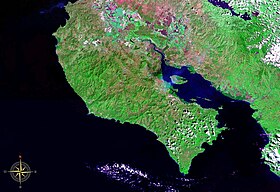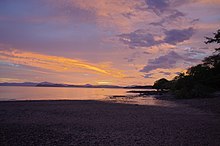This article needs additional citations for
verification. (December 2009) |


The Nicoya Peninsula ( Spanish: Península de Nicoya) is a peninsula on the Pacific coast of Costa Rica. It is divided into two provinces: Guanacaste Province in the north, and the Puntarenas Province in the south. It is located at 10°00′00″N 85°25′00″W / 10°N 85.4166667°W. It varies from 19 to 37 miles (60 km) wide and is approximately 75 miles (121 km) long, forming the largest peninsula in the country. It is known for its beaches and is a popular tourist destination.
The main transport and commercial centre in the region is Nicoya, one of the oldest settlements in Costa Rica. Ferries run between the town of Puntarenas on the mainland and the Nicoya Peninsula. There is an international airport in nearby Liberia and small domestic airstrips in Nosara, Carrillo, Tamarindo and Tambor. [1] The region was also featured in the book Blue Zones, by Dan Buettner, which focused on the longevity found among Nicoya's residents. [2]
Places of interest
Other notable settlements and places of interest in the area include (going roughly from north to south): Tamarindo, Santa Cruz, Nosara, Sámara, Naranjo, Paquera, Curu, Tambor, Montezuma, Santa Teresa, Mal Pais.
The Ostional Wildlife Refuge is the second largest beach where the turtles come to nest. One of their biggest nesting years had over 500,000 females come ashore to nest in one season. [3] This refuge works in with the Nancite beach at Santa Rosa National Park. These two protected areas are two of the most important areas for the nesting of Olive Ridley turtles (Lepidochelys olivacea). [4] Two other common species of turtles that nest here are the leatherback turtles (Dermmochelys coriacea) and the Pacific green turtle (Chelonia mydas agassizii). The nesting generally occurs for three to five days. [4]
Conservation
There are a number of nature reserves and wildlife refuges such as Cabo Blanco, Camaronal, Cueva Murciélago, Curú, La Ceiba, Romelia and the Diriá National Park, as well as the projects on the islands of the adjacent Gulf of Nicoya.

Notable features
The Nicoya Peninsula is considered by Quest Network one of the Blue Zones in the world, where people commonly live active lives past the age of 100 years. [5] [6]
See also
References
- ^ Stater, Adam. "Transportation to the Nicoya Peninsula".
- ^ Buettner, Dan (21 April 2009) [2008]. "Contents". The Blue Zones: Lessons for Living Longer From the People Who've Lived the Longest (First Paperback ed.). Washington, D.C.: National Geographic. ISBN 978-1-4262-0400-5. OCLC 246886564. Retrieved 15 September 2009.
- ^ "Building positive links between the Ostional community and the conservation of Olive ridley sea turtles". panorama.solutions. 2017-05-29. Retrieved 2019-11-30.
- ^ a b "Ostional Wildlife National Refuge | WWF". wwf.panda.org. Retrieved 2019-12-02.
- ^ Anne Casselman (2008-04-14). "Long-Lived Costa Ricans Offer Secrets to Reaching 100". National Geographic News. Archived from the original on April 16, 2008. Retrieved 2011-03-04.
- ^ Dan Buettner (2007-02-02). "Report from the 'Blue Zone': Why Do People Live Long in Costa Rica?". ABC News. Retrieved 2011-03-04.
This article needs additional citations for
verification. (December 2009) |


The Nicoya Peninsula ( Spanish: Península de Nicoya) is a peninsula on the Pacific coast of Costa Rica. It is divided into two provinces: Guanacaste Province in the north, and the Puntarenas Province in the south. It is located at 10°00′00″N 85°25′00″W / 10°N 85.4166667°W. It varies from 19 to 37 miles (60 km) wide and is approximately 75 miles (121 km) long, forming the largest peninsula in the country. It is known for its beaches and is a popular tourist destination.
The main transport and commercial centre in the region is Nicoya, one of the oldest settlements in Costa Rica. Ferries run between the town of Puntarenas on the mainland and the Nicoya Peninsula. There is an international airport in nearby Liberia and small domestic airstrips in Nosara, Carrillo, Tamarindo and Tambor. [1] The region was also featured in the book Blue Zones, by Dan Buettner, which focused on the longevity found among Nicoya's residents. [2]
Places of interest
Other notable settlements and places of interest in the area include (going roughly from north to south): Tamarindo, Santa Cruz, Nosara, Sámara, Naranjo, Paquera, Curu, Tambor, Montezuma, Santa Teresa, Mal Pais.
The Ostional Wildlife Refuge is the second largest beach where the turtles come to nest. One of their biggest nesting years had over 500,000 females come ashore to nest in one season. [3] This refuge works in with the Nancite beach at Santa Rosa National Park. These two protected areas are two of the most important areas for the nesting of Olive Ridley turtles (Lepidochelys olivacea). [4] Two other common species of turtles that nest here are the leatherback turtles (Dermmochelys coriacea) and the Pacific green turtle (Chelonia mydas agassizii). The nesting generally occurs for three to five days. [4]
Conservation
There are a number of nature reserves and wildlife refuges such as Cabo Blanco, Camaronal, Cueva Murciélago, Curú, La Ceiba, Romelia and the Diriá National Park, as well as the projects on the islands of the adjacent Gulf of Nicoya.

Notable features
The Nicoya Peninsula is considered by Quest Network one of the Blue Zones in the world, where people commonly live active lives past the age of 100 years. [5] [6]
See also
References
- ^ Stater, Adam. "Transportation to the Nicoya Peninsula".
- ^ Buettner, Dan (21 April 2009) [2008]. "Contents". The Blue Zones: Lessons for Living Longer From the People Who've Lived the Longest (First Paperback ed.). Washington, D.C.: National Geographic. ISBN 978-1-4262-0400-5. OCLC 246886564. Retrieved 15 September 2009.
- ^ "Building positive links between the Ostional community and the conservation of Olive ridley sea turtles". panorama.solutions. 2017-05-29. Retrieved 2019-11-30.
- ^ a b "Ostional Wildlife National Refuge | WWF". wwf.panda.org. Retrieved 2019-12-02.
- ^ Anne Casselman (2008-04-14). "Long-Lived Costa Ricans Offer Secrets to Reaching 100". National Geographic News. Archived from the original on April 16, 2008. Retrieved 2011-03-04.
- ^ Dan Buettner (2007-02-02). "Report from the 'Blue Zone': Why Do People Live Long in Costa Rica?". ABC News. Retrieved 2011-03-04.